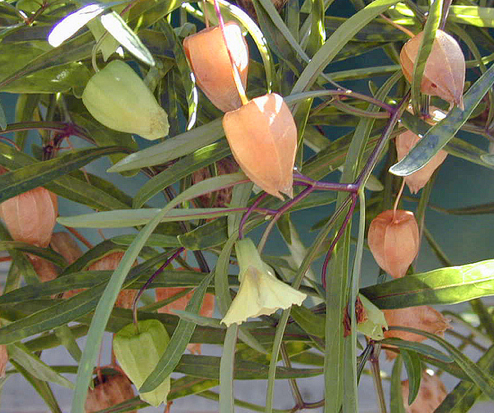
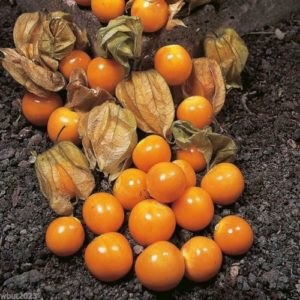
From a foraging point of view it was a very berry weekend starting with Coastal Ground Cherries, Physalis angustifolia in Port Charlotte. Our timing was good, their husks were gold to a tan, dry and papery. Inside the fruit was deep yellow to gold, tangy in taste. Ground cherries ripen from green to gold, getting sweeter and tangier as they go along. But they can often have a bitter aftertaste either from being under ripe or some species just retain some bitterness. A little aftertaste of bitterness is okay but the best is when there is none. Thus one always tastes a ripe ground cherry then you wait a minute or so for any bitterness to appear. Strongly bitter Ground Cherries should be cooked. And if they still taste bitter after cooking them don’t eat them.
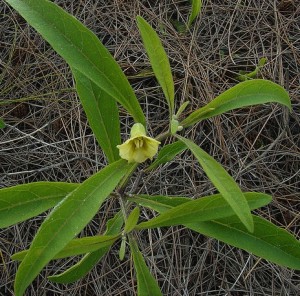
While locally Ground Cherries can fruit nearly all year, they do produce a spring and fall crop. In cooler climes — most of North America — they just have one season ripening in late summer and fall. Here our fall crop tends to be better than our spring one. Spring ground cherries can rot on the plant or get damaged by insects and that is also when I tend to find more bitter ones. But this time of year brings out the best in ground cherries. One can find whole, undamaged, very ripe Ground Cherries in significant numbers. You can make a pie out of them if you can manage to get some home uneaten. Incidentally there is a second local ground cherry that resembles the Coastal Ground Cherry. It’s Physalis walteri, also known as Starry-Hair Ground Cherry and Sand Cherry. It has star-shaped hairs on the lower edges of the leaf which are visible with a hand lens. Still has edible berries, however as does P. angulata, and other common Ground Cherry. To read more about Ground Cherries go here.
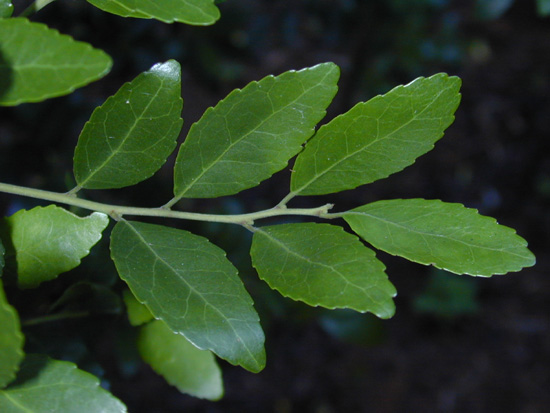
When is Cassine not Cassine? The issue came up in a foraging class this past weekend in Melbourne, Florida. The confusion flows from an old common name and a modern botanical name. More than a century ago a popular caffeinated drink was made from Yaupon holly leaves. It was called “Cassine” after Native American use. You will find this “Cassine” in old references and unfortunately on the copy-cut-and-past internet. So far it is fairly clear: “Cassine” was a tea-like drink made for the leaves of the Yaupon Holly, Ilex vomitoria. There is another holly, the Dahoon Holly. It has little or no caffeine, a lot of theobromine, is a laxative and toxic to dogs. Not a good Holly to make a tea out of. However, when botanists decided to give a botanical name to the Dahoon Holly they called it Ilex cassine. The problem should be clear now. People read of a holly drink called “Cassine” and then see the species Ilex cassine and think the latter can be used to make the former. Wrong. Leave it to botanists to make The tea “cassine” is made form the Ilex vomitoria. There is a huge amount of confusion and wrong information about this on the internet. You can read about Yaupon Holly here.
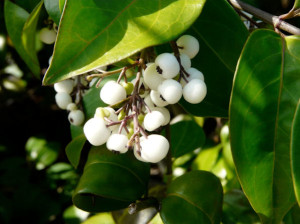
I spent a week or so along Florida’s southwest coast staying in Ft. Myers, Naples and on Sanibel Island. The latter could easily be called Sea Grape Island, Cocoplum Island or Poison Ivy Island. The cocoplums were ripe and everywhere (as was Poison Ivy, apparently enjoying the tropical climate.) This is an area where a frost or freeze is rare so the landscape is populated with many species just not seen further north. This make foraging in Florida interesting with a temperate forest on the north end tropical vegetation on the south end. Among my sightings were the Randia aculeata, or White Indigoberry — barley edible — Foresterea segregata, a so-called wild olive or Florida Privet — not edible but I wonder about that — and the Beach Naupaka, or Scaevola taccada whose leaves have been used as famine food. Do not eat the white berries. There were also a lot of Pond Apples growing wild, again barely edible. It’s an area I enjoy and I might look for a (very) small condo there in my retirement…
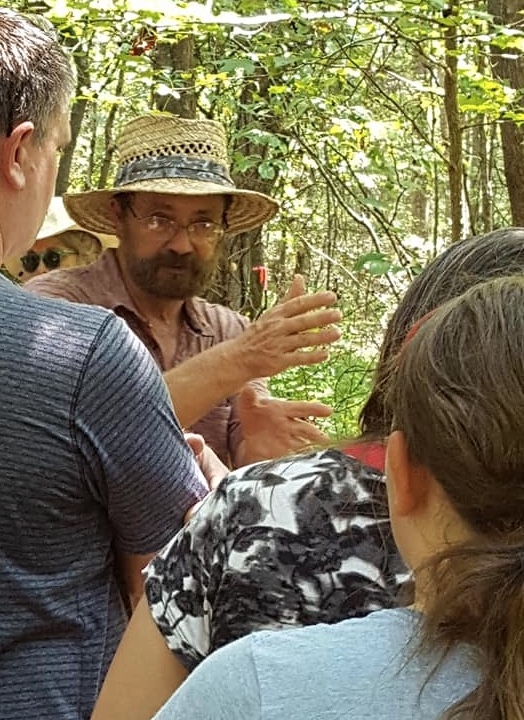
Plans for foraging classes in South Carolina are shaping up. I will be in Honea Path July 13th and 14th with two classes each day, approximately 9 a.m. and 1 p.m. at the Putney Farm, 1624 Taylor Road, Honea Path. There may be a small variation in the schedule between now and then depending upon the turn out but that’s the foraging plan at the moment. People are signing up already. For more information or to get on a list for a class email either me at GreenDeane@gmail.com or the Putney Farm at putneyfarm@aol.com. They have a lot of things going on this week but will gear up in earnest next week for this two-day event. There is also more information directly below in Foraging Classes.
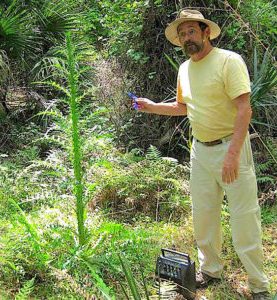
Foraging classes this weekend are in Apopka and Sarasota. We will be visiting Wekiva State Park on Saturday. ARRIVE EARLY. It’s an area with a focus on native plants in that there are few species associated with civilization there. We will also have to contend with high dry areas and early thunderstorms, if the weatherman is right… as they say, stand by. And Sunday we are in Sarasota, always a nice class location this time perhaps with an emphasis on salad food..
Saturday June 8th, Wekiva State Park, 1800 Wekiwa Circle, Apopka, Florida 32712. 9 a.m. to noon. Arrive early as there will be a lot of people wanting to go to the springs to swim. There is a park admission Fee: $6 per vehicle. Limit 8 people per vehicle, $4 for a single occupant vehicle, $2 pedestrians or bicyclists. Meet at the Sand Lake parking lot (road on left after entrance. Go to end of road.) Unlike city parks or the urban area, Wekiva Park is “wild” Florida. There are very few weeds of urbanization. The edibles are mostly native plants and far between. There is a lot of walking in this class. We meet at the Sand Lake Parking lot. After entering the park and passing a small parking lot on left you will have a choice of turning right or left. Turn left. Go to the end, about 1.5 miles.
Sunday, June 9th, Red Bug Slough Beneva Road, Sarasota, FL, 34233. 9 a.m. to noon. Meet at the parking lot.
Saturday, June 15th, Eagle Park Lake, 1800 Keene Road, Largo, FL 33771. 9 a.m. to noon. Meet at the pavilion near the dog park.
Sunday, June 16th, Ft. Desoto Park, 3500 Pinellas Bayway S. St. Petersburg Fl 33715. Meet at the parking lot of the fishing pier, northeast end of the parking lot. 9 a.m. to noon. There is a fee to get into the park. The fishing pier is the first one you encounter. It’s about halfway along the SW/NE road along the southern end of the park and called the Bay Pier. This is also father’s day so perhaps you can go fishing or swimming after class. High tide is at noon that day at the park. Also that evening at 7:15 pm. there is a “shoot the full moon” event at the park. It is to watch the full moo16n rise between the Sunshine Skyway Spans.
Saturday, June 22nd, Blanchard Park, 10501 Jay Blanchard Trail, Orlando, FL 32817. 9 a.m. to noon. Meet next to the tennis courts by the YMCA building.
Sunday, June 23rd, Spruce Creek Park, 6250 Ridgewood Ave. Port Orange, 32127. GPS: N 20°05’35.4″ W080°58′.26.2″ 9 a.m. to noon. Meet at the pavilion.
Saturday June 29th: Ft. Meade Outdoor Recreation Area, 1639 Frostproof Highway, Fort Meade, FL 33841. (Frostproof Highway is also Route 98.) 9 a.m to noon. Meet at the brown bathrooms in the middle of the park which is due south from the highway. (Not the tan bathrooms near the intersection.)
Sunday June 30th, John Chestnut County Park: 2200 East Lake Road, Palm Harbor, FL 34685. 9 a.m. to noon. Meet at the trail head of the Peggy Park Nature Walk, pavilion 1 parking lot, inside the park.
Saturday, July 13th, Sunday July 14th, 1624 Taylor Road, Honea Path, South Carolina. Ever want a class with Green Deane but he never seems to come to your neck of the woods? Then mark mid-July on your calendar. Green Deane will have at least four foraging class in Honea Path. Times 9 a.m. and 1 p.m. both Saturday and Sunday, rain or shine (except hurricanes.) Cost is $30 per adult, supervised children free. All of Green Deane’s classes are hands on, walking outside over two to three hours. Wild edible plants, medicinals and perhaps a mushroom or two will be on the agenda. For more information you can contact Putney Farm on Facebook or Green Deane at GreenDeane@gmail.com.
Saturday, July 20th, Blanchard Park, 10501 Jay Blanchard Trail, Orlando, FL 32817. 9 a.m. to noon. Meet next to the tennis courts by the YMCA building.
Sunday, July 21st, Dreher Park, 1200 Southern Blvd., West Palm Beach, 33405. 9 a.m to noon. Meet just north of the science center in the north section of the park.
Saturday, July 27th, Wickham Park: 2500 Parkway Drive, Melbourne, FL 32935-2335. 9 a.m. to noon.Meet at the “dog park” inside the park.
Sunday, July 28th, Bayshore Live Oak Park, Bayshore Drive. Port Charlotte. 9 a.m. to noon. Meet at the parking lot at the intersection of Bayshore Road and Ganyard Street. 9 a.m. to noon.
For more information, to sign up for a class, or to pay of a class go here.
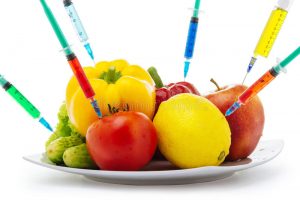
How safe is foraging? Excluding mushroom hunters, plant foragers have a good track record of staying alive. Plant foragers have about one accidental death every 20 years, and usually that’s from eating some member of the poison hemlock crowd. That should be a word to the wise. Locally, the nemesis is the water hemlock and it grows exactly where watercress grows. When I collect watercress I look at every piece before I collect or cook it, every single piece. Actually, there are several deadly local plants: Water hemlock, the Yew, Oleander, Castor Beans, and the Rosary Pea, the most toxic seed on earth. I have been asked to do a video on toxic plants but I am afraid someone will not understand what the video is about and eat the wrong plant. Most plant poisonings involve toddlers eating from the landscaping (toxic ornamentals) around their home, with the next highest incidence is toddlers eating the landscaping from their neighbor’s yard. Why we fill our home space with toxic plants rather than edible landscaping is beyond me. Excluding suicides, adult poisonings are extremely rare. So, don’t be afraid of foraging. Just be careful. Study. Take lessons. Go with a friend. ITEMize! (By the way, next in line for poisonings are dogs, horses and college students.)

Donations to upgrade EatTheWeeds.com and fund a book are going well. Thank you to all who have contributed to either via the Go Fund Me link, the PayPal donation link or by writing to Green Deane POB 941793 Maitland FL, 32794. Recent upgrades have been paid now the Forum needs work and several function problems need to be fixed specifically the search and categories. The other issue is finding an indexing program or function for a real book. Writing programs used to do it automatically if you designated a term for indexing. Now that most books are ebooks most writing programs do not provide and indexing function.
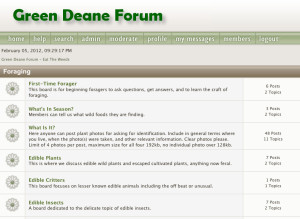
Want to identify a plant? Looking for a foraging reference? Do you have a UFO, an Unidentified Flowering Object you want identified? On the Green Deane Forum we chat about foraging all year. And it’s not just about warm-weather plants or just North American flora. Many nations around the world share common weeds so there’s a lot to talk about. There’s also more than weeds. The reference section has information for foraging around the world. There are also articles on food preservation, and forgotten skills from making bows to fermenting food. One special section is “From the Frightening Mail Bag” where we learn from people who eat first then ask questions later. You can join the forum by clicking on “forum” in the menu.
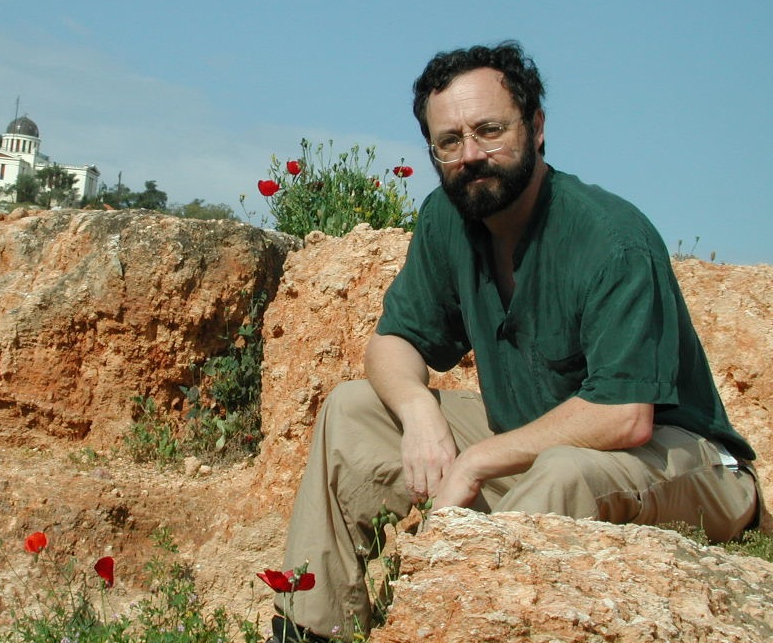
All My Videos are available for free on You Tube. They do have ads on them so every time you watch a Green Deane video I get a quarter of one cent. Four views, one cent. Not exactly a large money-maker but it helps pays for this newsletter. If you want to see the videos without ads and some in slightly better quality you can order the DVD set. It is nine DVDs with 15 videos on each for a total of 135 videos. Many people want their own copy of the videos or they have a slow service and its easier to order then to watch them on-line. The DVDs make a good gift for that forager you know especially as spring is … springing. Individual DVDs can also be ordered or you can pick and choose. You can order them by clicking on the button on the top right hand side of this page (if your window is open wide enough.) Or you can go here.
This is weekly issue 358.

